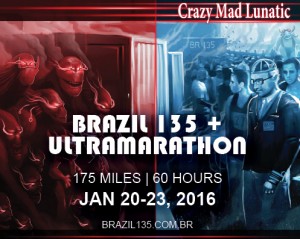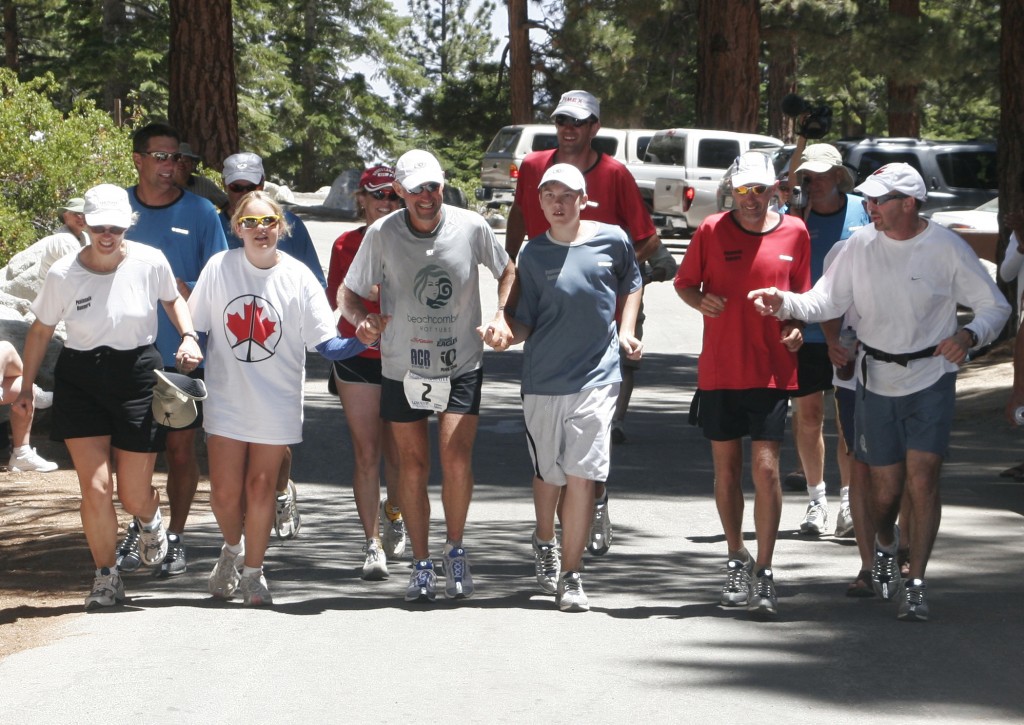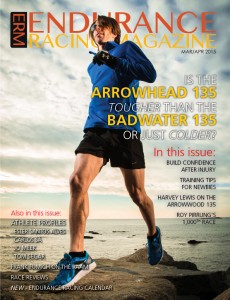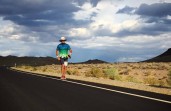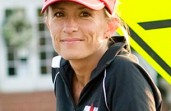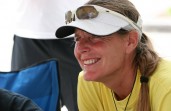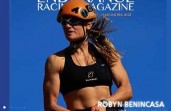By Alix Shutello
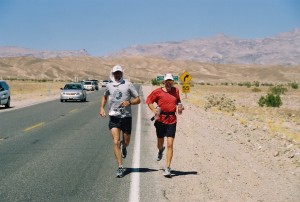 In four years, Ferg Hawke went from fat to fit to famous. Hes renown for his epic 2nd place finishes at Badwater, a record-breaking finish at the Marathon De Sables and has competed in hundreds of races including Western States and other international races. Now, after a few years off, he’s coming back better than before.
In four years, Ferg Hawke went from fat to fit to famous. Hes renown for his epic 2nd place finishes at Badwater, a record-breaking finish at the Marathon De Sables and has competed in hundreds of races including Western States and other international races. Now, after a few years off, he’s coming back better than before.
In 1987 Ferg Hawke was 30, overweight and according to his doctor, on the road to destruction with dangerously high blood pressure. He was prescribed blood pressure medication and informed that he was at high risk for heart disease, stroke, and diabetes. Hawke threw the prescription out and started running to bring his weight down.
To say that Hawke jumped into an exercise program is an understatement. Two years later and 40 pounds lighter, Hawke ran the Vancouver Sun Run 10K in April of 1989 and then completed his first marathon and sprint triathlon in May and June respectively before competing in his first Olympic distance triathlon in July and then the Ironman Canada in August.
After finishing Ironman Canada and swore Id never do another Ironman but my time was good enough to qualify for the Hawaii Ironman in Kona, Hawke said.
It took a few friends and a few beers to convince him to go to Kona which ultimately kick-started a career in Ironman races. Hawke went on to complete in six Ironman races including a personal best—a 27th place finish at IMC in a time of 9:27 with a 3:01 marathon. Other triathlon highlights during this time included competing at the Triathlon World Championships in Surfers Paradise Australia as a member of the Canadian national team and a 3rd place finish at the Ultraman World Championships in Kona, Hawaii.
Today, however, Hawke is known more as an ultra runner than a triathlete. Before his two children were school age, Hawke was working for Air Canada and this shift prevented him from training appropriately for triathlons. He decided to focus on running because he could always squeeze in a run at night or with the kids piled into the double baby jogger.
Fate Becomes an Ultra Runner
In March 1995, a friend invited him to run a 50K, but the race was only a week away. Well once I finished laughing I gratefully declined his kind offer and wished him luck, Hawke said.
Something about running 50K in the mountains sounded intriguing, however, and although he wasnt prepared for race that long Hawke called his friend back, accepted his offer, and went with him to the Chuckanut Mountain 50K about an hour’s drive south in Washington state.
To Hawkes amazement, he won the race.
Let me be clear, this wasn’t the star studded track meet like today’s Chuckanut Mountain 50K with the likes of Geoff Roes, Hal Koerner, Scott Jurek, etc., but hey I won! Hawke explained.
It was a miserable day with snow on the higher elevations of the race and pouring rain at sea level. Hawke arrived back to where the race started and just stopped at what he thought was the finish line. There wasn’t a person in site until a guy opened a car door yelled, What’s your name? The man wrote something on his clipboard, said, “Good job,” and slammed the car door.
So while that wasnt the typical finish with race tape and cheering fans, Hawke still thought “how exciting!” He fell in love with the sport of trail running and entered another 50K and a 50-miler that summer. Within a few years he ran a couple of 100-milers including Western States and traveled to the Netherlands for the 100K World Championships.
Going Further: The Marathon de Sables
I read an article about this crazy run in the Sahara called The Marathon de Sables (MDS) in Morocco and thought that would be such an incredible adventure.
What Hawke discovered about himself was that the longer, hotter, and tougher the race was, the better he performed. What better place to test this theory, he thought. He gathered a bunch of his running buddies together at the local coffee shop and pitched his idea to run the MDS. I actually managed to convince two of them that running 150 miles across the Sahara Desert with a week’s worth of food and gear on our backs was a good idea and the three of us entered as a team, he said.
Hawke ran through the first four stages of the MDS in incredibly tough conditions with high winds causing blinding sand storms. When Hawke began the 50-mile ultra stage he was in 12th place but things were only about to worse as athletes fought through the worst sand storms in the events 17-year history with winds gusting to 50 mph and almost zero visibility. The Moroccan sand dunes, which athletes had to traverse after the 50-mile ultra stage were 20 miles across with a checkpoint half way at mile 10 and another at the far side. As he was running, Hawke couldnt see anyone ahead or behind him. The blowing sand covered footprints within seconds making navigation very difficult. Relying on his compass, Hawke made it to the first checkpoint but when he made it to what he thought was the other side of the dunes, there was no checkpoint.
Hawke wandered around in all directions searching for the checkpoint for what seemed like an hour. He was down to his last water ration when he heard the race helicopter hovering off to his left and ran in that direction straight to the final checkpoint before the finish of the second stage. He continued on to stages three and four, and ran hard the last eight miles of stage four on a dry lake bed. It was getting dark and he removed his sunglasses so he could see the course markers, but the winds were blowing sands that ultimately got lodged in Hawkes eyes. When he crossed the finish line at this stage he was in 7th place but was practically blinded and had to be escorted to the medics tent where medical personnel took over an hour to rinse the sand out of his eyes. The doctors told him he had lacerated his corneas. The doctors taped gauze over his eyes and instructed me to leave it on until the marathon stage in two days time, Hawke said.
Fortunately, Hawkes eyes healed enough for him to run the final two stages finishing in 8th overall, which was not only the first time a North American athlete had finished in the top ten at the Marathon de Sables but it was also the highest placing by a North American in the 26-year history of the race until Mike Wardians incredible 3th finish in 2011.
Badwater
In 2004 Hawke entered Badwater, and while it was on his to do list he had trepidations about doing it. The Sahara was hot, but the Marathon de Sable is held in April so it never really got hotter than 100°F. At Badwater, temperatures in the summer heat in Death Valley in July could range anywhere from 120°F to 130°F.
I knew that even more than focusing on hill training to prepare for the more than 13,000 feet of elevation gain I would need to come up with a plan to ready myself for the heat, he said. To do this Hawke developed a two-pronged heat training strategy. First, he built a sauna big enough to fit his treadmill inside. Second he travelled from his home in the Pacific Northwest to Death Valley to train on the course in the heat.
Hawke began his sauna training at the beginning of May, 10 weeks before the race, starting with daily one hour sessions with the temperature at 110°F. Over time, he increased his sauna runs to two hours at temperatures up to 140°F. At the end of May, Hawke drove to Death Valley and spent a week completing two or three training sessions each day in the heat. The temperature reached 118°F during the day and dropped to the low 90s at night. He purposely left the air conditioning off in his car and slept on an air mattress in the desert for seven days. During that week he logged over 140 miles including a 50-mile run through Death Valley in the heat of the day finishing with a 5,000-foot climb up to Towns Pass.
After his week at Death Valley he drove to the Grand Canyon and ran 48 miles rim to rim in the heat. I felt that ‘Death Camp,’ as I aptly named it, was a huge success. Not only from a conditioning and heat training aspect, but I was unquestionably better prepared psychologically as my confidence grew after surviving the heat of Death Valley on the very same roads that I would be suffering on a during Badwater, he added.
Badwater has three start times. This spreads the athlete’s and crew out on the course so the public highway is not too congested. The 6:00 a.m. group is reserved for what the race director, Chris
Kostman, would consider to be the slowest group. Hawke was in the 8:00 a.m. for the middle of the pack runners and his pre-race strategy was to push the pace early while it was a relatively cool 100°F, then ease off and try to survive the hottest part of the day from Furnace Creek to Stove Pipe Wells. He hoped his months of 100-plus mile training weeks and mega hours running in the sauna was enough to get him to the finish. His strategy worked well, and he passed everyone from the 6:00 a.m. group by the 40-mile mark and held off all the 10:00 a.m. elite starters all the way through the race to the finish line. It was an amazing feeling to be the first athlete to cross the finish line but this didnt mean he won the race. He now had to wait to see how many of the 10:00 a.m. starters would cross the line within the two hour time difference. Dean Karnazes crossed the line to claim the overall victory and Hawkes time of 27:30 was good enough for 2nd place. “Going into the race I felt if everything went well I had a shot at a top 10 finish. Second place, and only seven and a half minutes slower than ultra-marathon legend Dean Karnazes was the closest finish in the history of the race and beyond my wildest dreams,” he said.
But that seven and a half minutes needled at Hawke to the point where he signed up to do the race again in 2005.
In his second attempt to finish Badwater, documented in the film, The Distance of Truth, Hawke shaved a whopping 57 minutes off his 2004 time finishing in 26:33, but the win still evaded him. Scott Jurek, who had been having severe complications in the heat fought hard and caught Hawke on the mountain. The two would pass each other twice during the night and ultimately Scott won the race knocking 33 minutes off the course record finishing in under 25 hours.
Hawke ran Badwater again in 2006 finishing in 4th place and then went on a hiatus to renovate his home. He put some of the weight back over a couple of years but then started to regain his fitness. In 2011, Hawke joined Canadian ultra marathoner Ray Zahab in Bolivia and ran over 200 kilometers as a guide on one of Zahab’s youth expeditions. Hawke enjoyed the experience so much he joined Ray in India where they ran 280 kilometers across the Thar Desert.
For more information on Ray Zahab’s running expeditions, visit www.impossible2possible.com.


